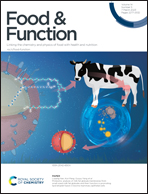Analyzing the mechanism by which oyster peptides target IL-2 in melanoma cell apoptosis based on RNA-seq and m6A-seq†
Abstract
Melanoma is a kind of skin cancer with high malignancy and strong proliferation and invasion abilities. Chemotherapy drugs in the clinic have the disadvantages of high price and high toxicity. Peptides are natural active ingredients that have many functions and are safe and effective. Previous studies have shown that oysters are rich in protein and have antitumor effects. In this study, a high-throughput strategy combined with MALDI TOF/TOF-MS and molecular docking was developed to screen peptides with antitumor functions from oyster hydrolysate. Three dominant peptides were predicted to have similar functions to IL-2 via molecular docking. Then, the activity of the peptides was confirmed in B16 cells, and we found that the three peptides increased the apoptosis of B16 cells. Furthermore, via RNA-seq and m6A-seq of B16 cells treated with the peptides, we found that ILADSAPR downregulates the expression of Pcna, Tlr4, and Ncbp2 and upregulates the expression of Bax, Bad, Pak4, Rasa2, Cct6, and Gbp2. ILADSAPR inhibited B16 cell proliferation and promoted cell apoptosis by regulating the expression of these genes. In addition, the result of metabolic pathway analysis also proved this point. This study provides a preliminary reference for antitumor research on oyster peptides.



 Please wait while we load your content...
Please wait while we load your content...